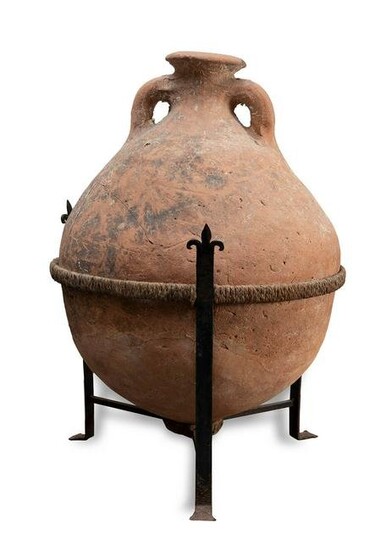Roman Dressel 20 type amphora for preserving oil, 1st
Roman amphora of the Dressel 20 type, 1st century.
Terracotta.
Measurements: 74 x 58 x 58 cm.
Roman amphora for conserving oil made in terracotta, of the Dressel 20 type, with a globular body, a narrow circular base, a short neck with a hollow mouth and two vertical handles. Dressel 20 globular amphorae are one of the best-known amphorae, being the main container for High-Imperial Baetic oil. They were widely used in the western half of the Roman Empire. The amphora is a type originating from Greek pottery, widely used in the Roman Empire, characterised by a tall fusiform-shaped vessel with a narrow neck and two openwork handles on either side of it, usually ending in a point to place it sunk into the sandy ground or on a stand. It was used by the ancient Greeks and Romans as the principal means of transporting and storing grapes, olives, olive oil, cereals, fish, wine and other commodities. However, during the Roman period it was also frequently used for funerary purposes, as a container for the ashes of the deceased. The average volume of an amphora was about 25-30 litres (one cubic foot); its weight and contents, in an amphora filled with water, gave rise to the talent, as a measure of weight and also a monetary unit. Early Greek types had a continuous curved profile, while more modern and Roman examples have a clearly differentiated upper part (neck and mouth) from the rest of the body. Some of these pieces, such as the famous Panathenaic amphorae, had pictorial decorations, especially those of Greek origin. However, during the Roman Empire, due to the expansion of trade, their use was focused on the transport and storage of foodstuffs, so they tended to be simple, with no decoration other than modelling.
Estimate
Time, Location
Auction House
Roman amphora of the Dressel 20 type, 1st century.
Terracotta.
Measurements: 74 x 58 x 58 cm.
Roman amphora for conserving oil made in terracotta, of the Dressel 20 type, with a globular body, a narrow circular base, a short neck with a hollow mouth and two vertical handles. Dressel 20 globular amphorae are one of the best-known amphorae, being the main container for High-Imperial Baetic oil. They were widely used in the western half of the Roman Empire. The amphora is a type originating from Greek pottery, widely used in the Roman Empire, characterised by a tall fusiform-shaped vessel with a narrow neck and two openwork handles on either side of it, usually ending in a point to place it sunk into the sandy ground or on a stand. It was used by the ancient Greeks and Romans as the principal means of transporting and storing grapes, olives, olive oil, cereals, fish, wine and other commodities. However, during the Roman period it was also frequently used for funerary purposes, as a container for the ashes of the deceased. The average volume of an amphora was about 25-30 litres (one cubic foot); its weight and contents, in an amphora filled with water, gave rise to the talent, as a measure of weight and also a monetary unit. Early Greek types had a continuous curved profile, while more modern and Roman examples have a clearly differentiated upper part (neck and mouth) from the rest of the body. Some of these pieces, such as the famous Panathenaic amphorae, had pictorial decorations, especially those of Greek origin. However, during the Roman Empire, due to the expansion of trade, their use was focused on the transport and storage of foodstuffs, so they tended to be simple, with no decoration other than modelling.



